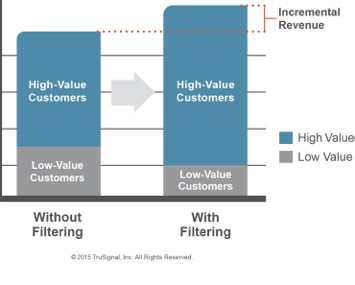Save 50% on a 3-month Digiday+ membership. Ends Dec 5.

Written by Pete LaFond, vice president of marketing, TruSignal, Inc.
If you’re a direct response marketer and your conversion rates are 100 percent, this article probably isn’t for you. For the rest of you looking to move the needle in your digital campaigns, continue on.
The premise of direct response campaigns is that they drive immediate results. As a marketing professional, you’re likely testing and iterating constantly to figure out how to optimize each channel to the nth degree, striving to squeeze out a few more new customers with an acceptable cost per acquisition.
The challenge is, no matter how many levers you pull, your campaigns always target a combination of high and low converters. But what if you could avoid many of the low converters? Here’s where NOT targeting (a.k.a. audience filtering) comes in to play.
Turning targeting on its head
Audience filtering should be a critical part of your digital strategy. Audience filtering, also known as “exclusion targeting,” allows you to exclude people from your campaigns who are highly unlikely to convert. In turn, the money saved by not buying those people can be redirected toward advertising to quality prospects —people likely to convert with an attractive revenue-per-lead.
While it’s common practice to target the best prospects with the highest revenue-per-lead, you can also create extremely efficient campaigns by eliminating unlikely converters pre-campaign, before valuable resources are exhausted.
Not your typical exclusion targeting
Today, there are multiple ways to exclude audiences from your media buy, but most of the filters are either too specific or restrictive, thereby eliminating exclusion targeting at scale (e.g. if user A visited website X in past 2 days, then exclude from retargeting campaign). Or, they are so broad (age, geography, etc.) that you can’t utilize exclusion targeting without throwing the baby out with the bath water.
Ad position: web_incontent_pos1
Audience filtering, on the other hand, uses your known customer data and predictive analytics to build a custom model to score people, one-at-a-time, and determine likelihood to NOT convert. Using this technique, you can pinpoint and eliminate specific individual poor performers who are dragging down your overall conversion rate. The result? Fewer wasted impressions and a lower CPA.
Put the new strategy to the test
It’s unlikely you’ll ever get a 100 percent conversion rate, but predictive audience filtering can reduce wasted impressions by 20 percent or more and get you one step closer to targeting nirvana. Understanding who to avoid can be just as powerful as understanding who to target.
More from Digiday

Ulta, Best Buy and Adidas dominate AI holiday shopping mentions
The brands that are seeing the biggest boost from this shift in consumer behavior are some of the biggest retailers.

Digiday+ Research Subscription Index 2025: Subscription strategies from Bloomberg, The New York Times, Vox and others
Digiday’s third annual Subscription Index examines and measures publishers’ subscription strategies to identify common approaches and key tactics among Bloomberg, The New York Times, Vox and others.

U.K. retailer Boots leads brand efforts to invest in ad creative’s data layer
For media dollars to make an impact, brands need ad creative that actually hits. More CMOs are investing in pre- and post-flight measurement.
Ad position: web_bfu

